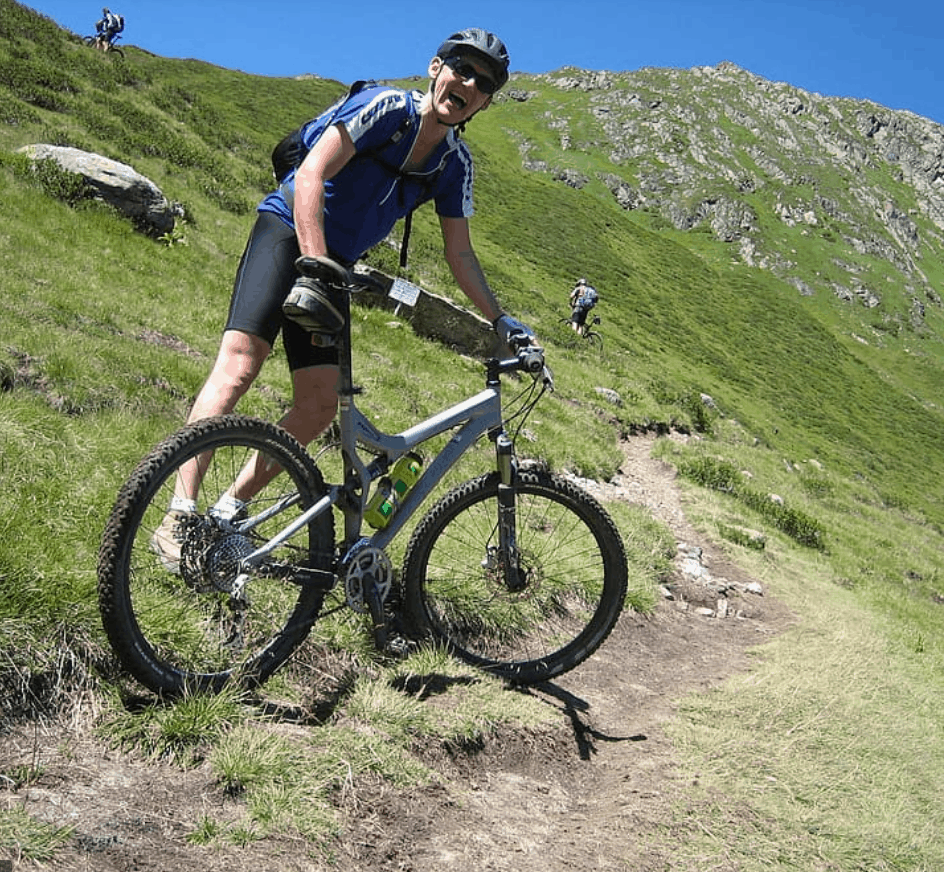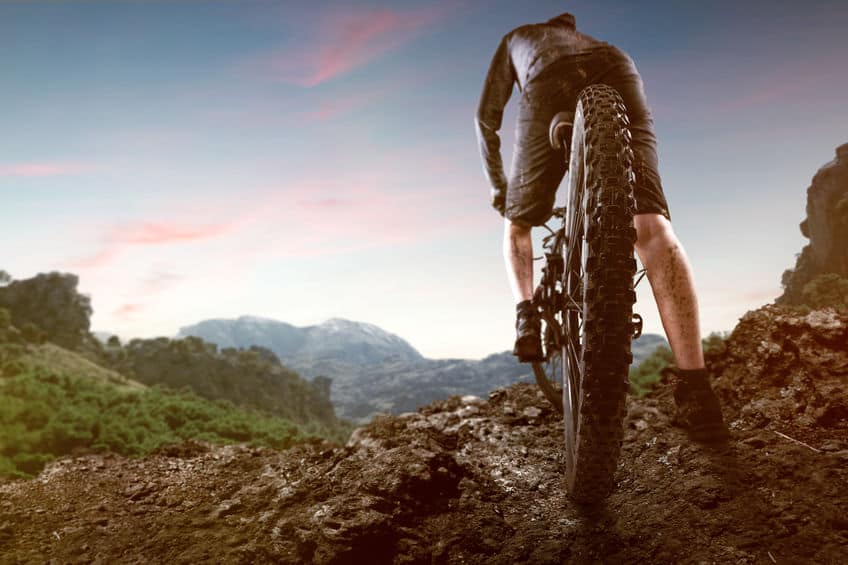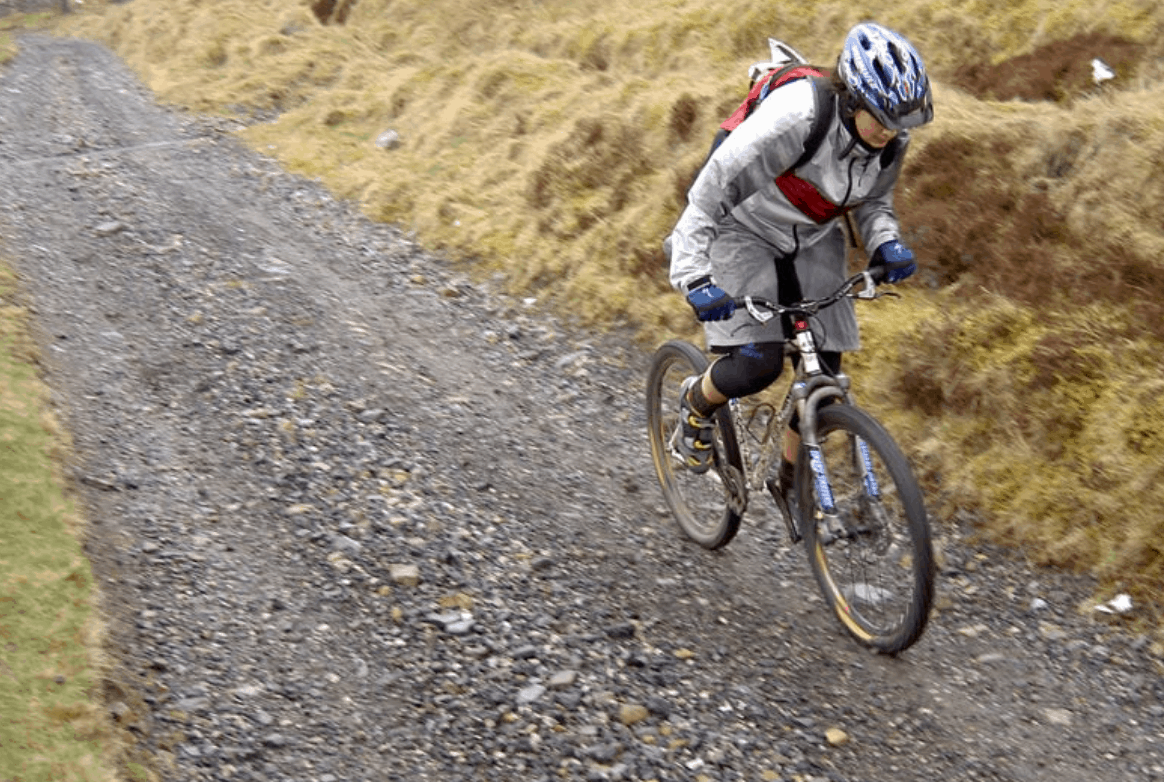You will spend the majority of your time climbing on your mountain bike. It takes way longer to ride up the hill then is does to descend. Knowing this it’s important to make sure your climbing skills are on point. Climbing can be just as fun as the descent once you get your fitness conditioning up and know some simple nuances that will improve your fundamentals. In this post we will offer 7 tips that will help you improve your mountain biking climbing skills.
7 Tips To Improve Your Skills
- Tip 1 – Pace Yourself
- Tip 2 – The Gears & Gear Set up
- Tip 3 – Don’t Forget To Breathe
- Tip 4 – Stay Seated & Drop Your Chest
- Tip 5 – Carry Momentum Into The Climb
- Tip 6 – Improve Your Overall Fitness
- Tip 7 – Tip 7 – Focus On Your Cadence
The Basics
Before we dive into the 7 tips let’s talk about the 3 basic forms of climbing..
- Long and gradual climbs that require steady moderate to high effort to get to the top.
- Short steep climbs without obstacles that require high effort for a short amount of time.
- Technical steep and gradual climbs that require focus, solid bike skills and stamina to navigate. This is the most difficult type of climbing.
Tip 1 – Pace Yourself
Your climb will be the hardest part of your mountain bike ride. You’ll be pushing your heart rate up to high levels on these climbs so it’s really important that you pace yourself. A good tip is to start off the climb slowly and ease into it. You can start in an easier gear with more spinning. Once you get into that higher workout zone and maintain it you can boost your effort.
If you burn out on the way up the hill you’ll have to stop and restart. That is not ideal and sometimes you’ll be forced to walk your bike up to the top if the terrain is too steep. Pacing yourself properly takes a lot of trial and error and understanding where you are from a fitness level.

One way of approaching this is to break each hill in half (assuming you know the trail). Ride the first part of the hill at an easy pace hold a little back. Once you get half way turn it up and push harder. Working out in that higher zone is an excellent way to improve your fitness levels for future rides as well. There’s quite a bit of science behind heart rate training in mountain biking.
Tip 2 – The Gears & Gear Setup
Some mountain bikes will have a one chain ring or single drivetrain set up. This will reduce the amount of gears you have and could make it more difficult to navigate the super steep stuff and also reduce your ability push on flats in a low gear.
The benefits of a single ring set up is it will reduce your overall weight of the bike. In my opinion, that’s an option for more competitive mountain bikers. If you are a casual or recreational mountain biker I would opt for a 30-36 gear set up. This will give you ample gears to help you handle all of the inclines you’ll encounter.
Anticipating the hills is really important. If you it the bottom of that hill in the wrong gear you might slow down so much you’ll have to hop off the bike. Practice approaching the hill and be prepared to switch the gears so that your gear shifter easily moves the chain with a popping sensation.
If you are snapping gears into place and adding that extra pressure you will likely wear out your chains and chain rings quicker. Shifting at the right time takes practice but you will improve over time. Once you get used to it you’ll find climbing way easier.
Tip #3 – Don’t Forget To Breathe
We already talked about pacing yourself but an important part of keeping your heart rate under control is to control your breathing. Making sure your lungs are taking in lots of clean fresh oxygen will go a long way in improving your climbing skills.
Here are 3 ways techniques to improve breathing while mountain biking:
- 3 In 3 Out – Practice inhaling for 3 seconds and then exhaling for 3 seconds. This will insure that you are emptying those lungs all the way before taking in that new breath. We are trying to avoid the shallow breathing. It’s good to practice this technique off the bike first before putting it into action on a tough climb.
- Altitude Breathing – This technique can be practiced on walks but you’ll still see the effects from the practice when you ride. You can try it on your bike as well but I wouldn’t do it on climbs. You simply breathe on your pedal strokes as follow. Inhale for 2 down strokes, hold your breath for 2 down strokes and then exhale for 4 down strokes. This simulates training in altitude.
- Stroke Count Breathing – A slightly different version of altitude breathing. In this technique you will get your pedal cadence to about 90-95 rotations per minute. Try this technique on a trainer or flat terrain first. You will inhale for 3 down strokes and then exhale for 6 down strokes. You can adjust the number of strokes but always exhale longer than the inhale.
Tip 4 – Stay Seated & Drop Your Chest
This technique is especially useful for those short steep climbs. You’ll find yourself quickly in the red so having a good strategy in these sections is really important so you don’t have to hop off and walk.
Keep your seat in its highest position if you have a dropper seat and stay seated. This will keep solid traction on the back wheel and help you keep powering up the hill. Keep a solid cadence and don’t stop pedaling.
As you get to the hill lean forward on your bike and get your chest over those handle bars to keep your front wheel on the ground. This will give you a balanced position on the bike and the added traction from your front wheel will make the climb easier.

If you are forced to get out of the seat be sure to keep your body in balance with your weight evenly distributed over both tires. You want to avoid your back wheel spinning out and your front wheel coming off the ground.
Tip 5 – Carry Momentum
It’s time to really hone in your skills as you approach the climbs. Being in the right gear is important and the timing of getting into that gear is critical.
Often people will make the mistake of being in too easy of a gear as you approach a steep technical section of the trail. You will quickly lose momentum and will likely spin out and have to dismount and walk up that portion of the trail.
A better method for handling steep technical is to carry your momentum in a lower gear. Drive through the area while focusing on the best line you can take. You’ll need to push hard for a few strokes to get through it but you better off than having to get off your bike and walk.
Mastering the skill of momentum takes time and experience. Just getting used to your gear shifters takes time. Especially if you have multiple chain rings. Momentum can save you a lot of time and work effort once you master it.
Tip 6 – Improve Your Overall Fitness
Mountain biking isn’t just the fun thrill of downhill. In fact, most of us got into mountain biking to avoid the treadmill or spin class for our workouts. Getting out in nature and riding is a great way to get and stay in shape and get outside.
The climb in mountain biking is the major fitness portion of your ride. Simply riding more will help to increase your fitness levels and help you climbing skills improve. This is probably the best way to increase your mountain biking fitness.
If you only ride weekly on a recreational basis then you’ll still want to maintain a solid fitness level to make your weekend rides enjoyable. If you don’t your destined to get dusted by your good friend or feel incredibly sore each week after the right. That’s not good for anyone.
So, if you fall into this category here are a few strategies if you to maintain and improve your overall fitness level for mountain biking:
- Use a stationary bike or trainer at least 2 other times per week. So if you are going to mountain bike on Saturday. Hop on a stationary bike or a trainer if you have one 2 other days that week. Don’t just spin on the bike. Put in some solid intervals so that you are getting your heart rate up. Here are two simple interval routines I’ll use in this strategy:
- 10 Minute Warm-up // 5 Min Hard-2 Min Recovery Repeat 3X // 5 Minute Cool Down
- 10 Minute Warm-up // 5-4-3-2-1 Minutes Hard-All With 1 Min Recovery // 5 Minute Cool Down
- Take a Spin class twice a week. A spin class isn’t a mountain bike but the group setting ads a increased level of motivation. Find a good class with a solid instructor. These classes will take you through intervals like shown above. The great part about a spin class is you don’t have to think you simply just show up.
- Cross train with other endurance sports. Any other endurance type of activity will still help your mountain biking stamina. It’s also a great way to work other muscle groups and let your main biking muscles recover. A few examples would be: Swimming, running, basketball, soccer etc..
Tip 7 – Focus On Your Cadence
Switch your gears in a way that you can keep your cadence the same. If you it the hill in a low gear you will likely come out of your seat and have to grind those pedals and burn out your legs. It’s difficult to gear down at this point since you’ve lost your momentum. If you can maintain that cadence as you switch the gears you won’t feel that same burn out.
Recently manufactures have come up with a 1 drive train set up. Although light weight and sleek it also will be harder to switch to a gear where you can maintain that smooth consistent cadence. If you have a 1 chain ring set you might consider moving to a 2-3 chain set with more gear options.
Staying seated is critical to maintaining your cadence. If you constantly pop out of your saddle your cadence will likely drop 20-40 RPMs and you’ve lost all momentum. Stay seated and keep that solid stead rotation moving through the climb.
Make sure your saddle height is at the right level for optimal pedaling. As an example if your dropper seat is set low you are going to burn out muscles that aren’t optimal for you climbing stroke. Most riders will want their seats at the highest position for optimal climbing.
I’ve hit quite a few hills that I simply couldn’t get up. It got me thinking how steep can a mountain bike actually climb. A lot of this will depend on the riders skill level of course but here’s an article that dives into this topic. Here is the link…
Climbing Mistakes To Avoid
- Get in right gear at base – If you are new to a trail you might end up being in too low of a gear when you hit the ascent. You’ll quickly lose momentum and will have to hop off the bike. Avoid this by keeping your head up and anticipate getting into an easier gear before you get there.
- Out of the gates too fast – If you push yourself too fast early you will burn out before you get to the top of the mountain. Again you might have to hop off the bike and you’re buddies will likely chide you when you slowly make it to the top. Avoid this by waiting til at least half way up the mountain before you start to really push yourself.
- Seatpost too low – When you seatpost is low you are in a very inefficient position and you are using muscles that are not optimal for climbing. Be sure to release that dropper seat to its high position to avoid this.
- Weight too far forward – Don’t move your weight so far forward that your back wheel spins out. You’ll normally come out of your saddle to do this and as we mentioned above you want to stay seated as much as possible when climbing.
- Line choice – Should you go over those rocks or around the outside. Keep you head up and anticipate your line. Many times riders will they can just cruise over those root structures or rocks only to find themselves spinning out. You don’t have as much momentum to handle the technical terrain on an ascent… so maybe choose the outside line and avoid the technical stuff.
- Tire pressure to high – If you keep your tire pressure too high you will lose traction on the climbs and spin out. Tire pressure is a tricky thing so you want to find that optimal PSI where you are not getting pinch flats with being too low & also not too high so that you lose traction on the climbs. Keys to consider are your type of tires & how much you way.
- Only having one chain – If you live somewhere really hilly you might need to turn that one chain ring into 2 or 3 drive trains so you can match your bike to the hilly terrain. If you only have one drive train as many new bikes do you’ve only got about 12 gears to choose from. Your range is really low if you are trying to ride hilly terrain.
- Lack of water and nutrition – Forgetting to load your camelbak with proper nutrition can ruin your ride and make your climbs way harder than they need to be. Mountain biking is a endurance sport so pack plenty of water and you plan on riding longer than 45 minutes you should pack some other nutritional supplements as well. A banana, protein bar or energy drink are all great options.
If you live in an area with inclement weather I encourage you to check out my post on how to climb in the rain. Here’s a link to that post…
Conclusion
I hope you found some value from these 7 tips on how to improve your mountain bike climbing. Don’t forget that the majority of your ride will be spent climbing so it’ll pay off to improve your climbing skills. Over time if your climbing skills improve you will find mountain biking to a more enjoyable experience. You’ll be able to dust your friends as you race to the top of the mountain.

